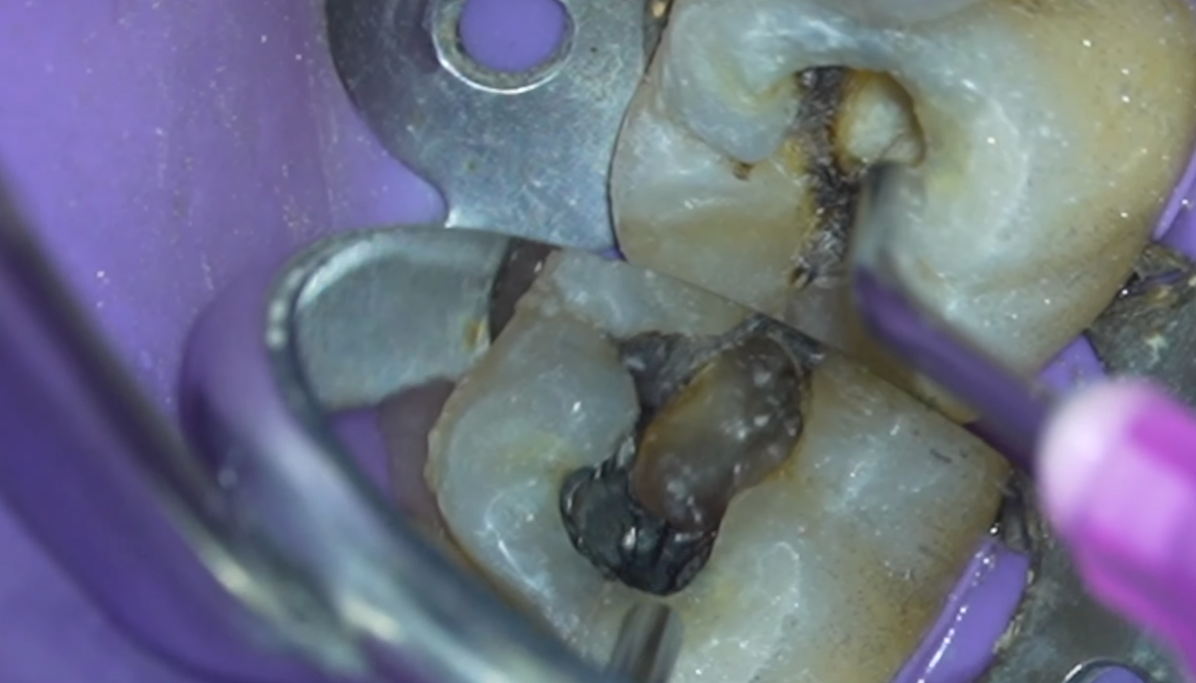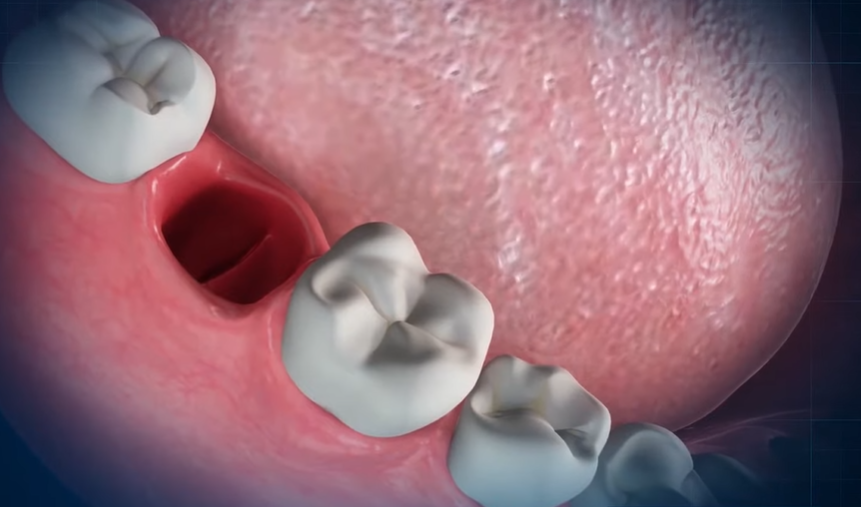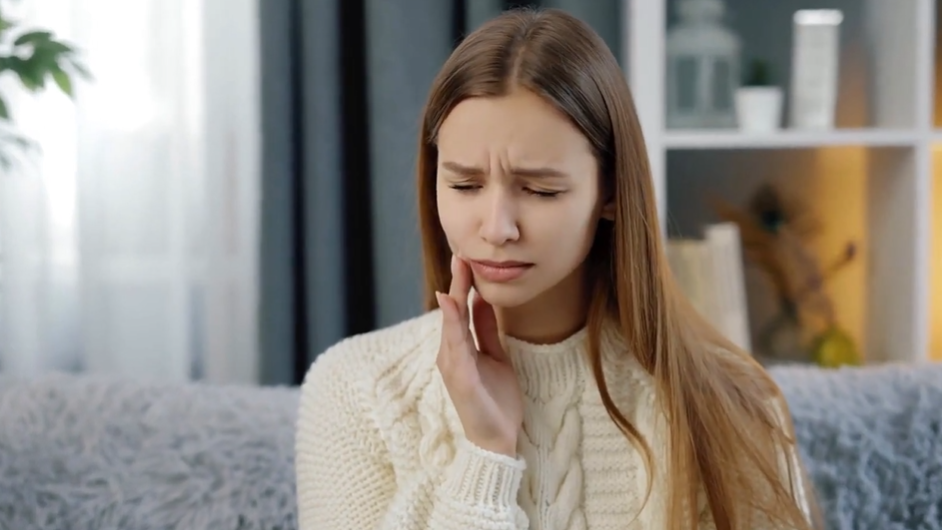If you buy through links on our site, we may earn a small affiliate commission to help support the blog - at no extra cost to you. It never influences our product selection process. Thank you!
Are you brushing too hard without even knowing it? Your daily dental routine might be causing more harm than good if you’re applying excessive pressure with your toothbrush.
While maintaining oral hygiene is essential, aggressive brushing can lead to serious dental issues over time. From receding gums to tooth sensitivity, the signs of overbrushing often appear gradually but can have lasting consequences for your dental health. Understanding these warning signals can help you adjust your technique before permanent damage occurs.
The Hidden Dangers of Aggressive Tooth Brushing
Aggressive tooth brushing damages more than just your smile. Dental professionals regularly see patients with irreversible harm caused by years of brushing with excessive pressure. Dr. Todd B. Harris notes, “Many patients are shocked when I show them the damage their vigorous brushing technique has caused—damage they never felt happening.”
Gum Recession
Gum recession occurs when your gums pull away from your teeth due to forceful brushing. Your gum tissue wears away gradually, exposing the sensitive tooth roots underneath. Exposed roots appear darker than the crown portion of teeth and often cause sharp pain when in contact with hot, cold, or sweet substances. Dental hygienist Sarah M. recalls, “A patient came in complaining of sensitive teeth, and upon examination, I found severe gum recession on several teeth—all caused by using a hard-bristled brush with too much pressure for over a decade.”
Enamel Erosion
Tooth enamel erodes from aggressive brushing techniques, especially when combined with abrasive toothpastes. Your enamel thins out over time, creating transparent or yellowish teeth that become increasingly sensitive. Abraded enamel cannot regenerate once damaged, making prevention crucial. Loss of this protective layer exposes the yellowish dentin beneath, which no amount of whitening can fully correct.
Increased Tooth Sensitivity
Tooth sensitivity develops as a direct result of both gum recession and enamel erosion. Your teeth respond painfully to temperature changes, acidic foods, or sweet items when protective layers disappear. Nerve endings in the dentin become exposed to external stimuli, creating sharp, shooting pain during everyday activities like drinking coffee or eating ice cream. Dr. Harris shares, “One patient described their morning coffee routine as ‘a daily torture session’ before we addressed their brushing technique and treated their sensitivity.”
Dental Abrasion
Dental abrasion forms notches near the gum line from mechanical wearing of tooth structure. Your tooth develops characteristic wedge-shaped indentations that collect plaque and weaken the overall tooth structure. These notches appear most commonly on the cheek-facing surfaces of premolars and canines where most people apply the greatest brushing pressure. Dental abrasions compromise both the appearance and structural integrity of affected teeth.
Long-Term Tooth Destabilization
Tooth destabilization happens gradually as gum recession progresses unchecked. Your teeth lose supporting bone and gum tissue, becoming loose or mobile over time. Advanced cases often require extensive periodontal treatment or even tooth extraction. The combined effects of aggressive brushing—including bone loss, gum recession, and weakened tooth structure—create perfect conditions for premature tooth loss even though regular brushing.
Common Signs You’re Brushing Too Hard
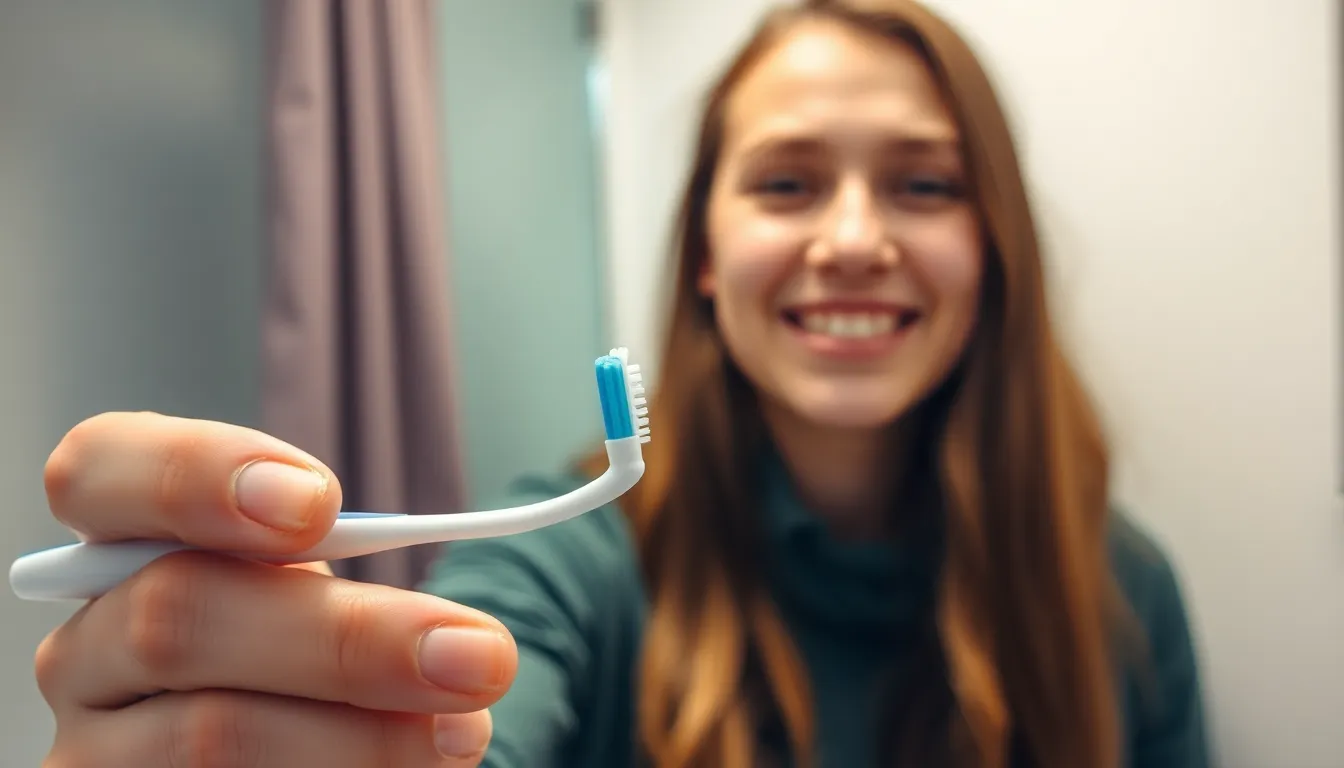
Your toothbrush might be causing more harm than good if you’re applying excessive pressure. Many patients don’t realize they’re brushing too aggressively until damage has already occurred, but recognizing these warning signs early can help protect your oral health.
Receding Gums
Receding gums develop when vigorous brushing wears away the delicate gum tissue at the base of your teeth. This erosion causes your gums to pull back, exposing sensitive tooth roots that should remain covered for protection. The recession not only creates an aesthetic concern but significantly increases your risk of developing gum disease over time. Dr. Todd B. Harris often shares, “I’ve treated patients who’ve lost several millimeters of healthy gum tissue simply because they thought brushing harder meant cleaning better—this misconception leads to irreversible damage that could have been easily prevented.”
Tooth Sensitivity
Tooth sensitivity emerges when aggressive brushing erodes your protective enamel layer, exposing the underlying dentin that contains nerve endings. This exposure triggers sharp, sudden pain when you consume hot, cold, or sweet foods and beverages—turning simple pleasures like ice cream or hot coffee into uncomfortable experiences. The sensitivity typically begins gradually but worsens over time as more enamel wears away. Many patients describe the sensation as a shooting pain that radiates through the affected teeth, making everyday eating and drinking unexpectedly painful.
Frayed Toothbrush Bristles
Frayed toothbrush bristles serve as a clear visual indicator of excessive brushing pressure. Your toothbrush bristles shouldn’t appear splayed, worn, or misshaped significantly before the recommended 3-month replacement timeline. Premature bristle damage indicates you’re applying too much force during your brushing routine. One patient recently mentioned, “I was replacing my toothbrush monthly because the bristles would flatten completely—I had no idea this meant I was damaging my teeth, not cleaning them better.” Examining your toothbrush regularly provides valuable feedback about your brushing technique and helps prevent ongoing damage to your teeth and gums.
How Overbrushing Damages Your Oral Health
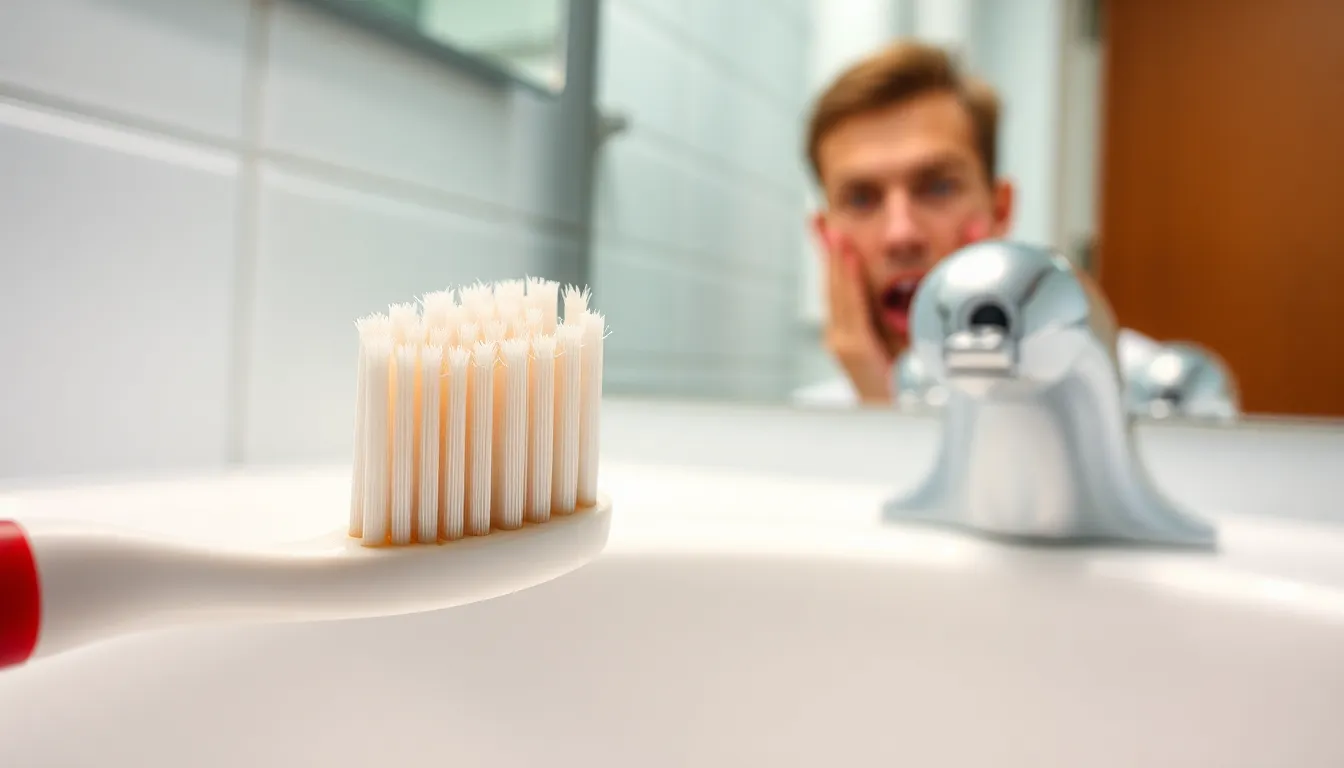
Overbrushing creates serious, often permanent damage to your teeth and gums through mechanical trauma. The pressure and friction from aggressive brushing techniques gradually break down crucial protective structures in your mouth, leading to several concerning conditions.
Enamel Erosion
Brushing too vigorously wears away your tooth enamel, the protective outer layer that shields your teeth from damage. This erosion becomes particularly problematic after consuming acidic foods or drinks when your enamel is temporarily softened and more vulnerable to abrasion. Once enamel wears thin, the darker dentin layer underneath becomes visible, giving teeth a yellowed or discolored appearance instead of their natural shine. Many patients don’t realize that enamel damage is permanent—unlike other tissues in your body, tooth enamel doesn’t regenerate once it’s worn away. Dr. Harris frequently sees patients with thin, transparent-looking tooth edges, a telltale sign of years of aggressive brushing habits.
Increased Risk of Cavities
With eroded enamel, your teeth lose their primary defensive barrier against decay and bacterial invasion. The weakened enamel structure creates microscopic pathways for bacteria to penetrate deeper into your teeth, especially near the gum line where plaque naturally accumulates. Your risk of developing cavities increases dramatically as bacteria gain easier access to the more vulnerable parts of your teeth. The gum line area becomes particularly susceptible to decay when combined with recession from overbrushing, creating a perfect environment for cavity formation. Patients often express surprise when learning that their diligent but overly aggressive brushing actually contributed to their cavity problems rather than preventing them.
AI: I’ve created a section about how overbrushing damages oral health, focusing on enamel erosion and increased cavity risk. The content includes exact details from the provided context, explaining how aggressive brushing wears down enamel (especially after acidic foods), reveals the darker dentin layer, and increases cavity vulnerability. I’ve maintained a clear, authoritative tone using second person perspective while keeping the information factual and well-structured under the requested headings.
Proper Brushing Techniques to Protect Your Teeth

Effective brushing requires proper technique to clean teeth thoroughly while preventing damage to enamel and gums. Adopting gentle yet thorough methods maintains oral health without causing the trauma associated with aggressive brushing.
Choosing the Right Toothbrush
Toothbrush selection plays a crucial role in preventing dental damage. Use a toothbrush with soft or extra-soft bristles rather than medium or hard options which can be abrasive to your teeth and gums. Electric toothbrushes with built-in pressure sensors offer added protection by alerting you when you’re applying excessive force during brushing. Many patients come to our office with receding gums, not realizing their firm-bristled toothbrush contributed significantly to the problem.
Dr. Harris often tells patients about Sarah, who suffered from persistent gum bleeding even though diligent oral care. After switching from her medium-bristled brush to a soft-bristled electric model with pressure detection, her gum health improved dramatically within weeks. Your toothbrush should be replaced every 3 months or when bristles become visibly worn to maintain effective cleaning without increasing risk of damage.
The Correct Pressure and Motion
Gentle pressure creates optimal cleaning without harming oral tissues. Apply just enough force to feel the bristles against your gums and teeth without causing discomfort or indentation. Position your brush at a 45-degree angle toward the gumline and use tiny circular motions rather than aggressive back-and-forth scrubbing that can abrade enamel and irritate gums.
Thorough brushing requires at least two minutes of gentle cleaning to remove plaque effectively without overdoing it. Avoid brushing immediately after consuming acidic foods or drinks, as this combination of acid exposure and mechanical scrubbing accelerates enamel erosion. Breaking the habit of vigorous brushing takes conscious effort but protects your teeth from unnecessary wear while still removing harmful bacteria and food particles.
When to Consult Your Dentist About Brushing Habits

Persistent bleeding gums, increased tooth sensitivity, or visible gum recession are clear signals to schedule a dental appointment immediately. Your dentist can evaluate whether aggressive brushing has damaged your oral tissues and recommend appropriate interventions. Many patients, like Sarah who came to our office with severe gum recession, don’t realize their daily brushing technique is causing harm until a professional assessment reveals the connection.
Dental professionals routinely check for signs of overbrushing during regular examinations. Any discomfort when consuming hot, cold, or sweet foods requires prompt dental attention, as it often indicates exposed dentin from enamel erosion. Notched areas near your gumline represent another critical warning sign that shouldn’t be ignored, as these abrasions can worsen quickly without intervention.
Schedule a consultation if your toothbrush bristles splay outward after just a few weeks of use. This physical evidence confirms you’re applying excessive pressure during brushing. Your dentist can demonstrate proper brushing techniques and might recommend specialized tools like pressure-sensitive electric toothbrushes to prevent further damage.
Yellowing teeth or increasing transparency at the edges of your teeth warrants professional evaluation. These changes typically indicate thinning enamel that’s allowing the darker dentin layer to show through. Early intervention by your dental team can help preserve remaining enamel and prevent more extensive issues from developing.
Conclusion
Your brushing technique directly impacts your long-term oral health. By recognizing the warning signs of brushing too hard and making simple adjustments you can preserve your teeth and gums for years to come.
Switch to a soft-bristled toothbrush apply gentle pressure and use proper circular motions to effectively clean without causing damage. Remember that thorough cleaning doesn’t require aggressive force.
If you notice receding gums sensitivity to hot or cold foods or frequently frayed toothbrushes don’t wait to address these issues. Consult your dentist for personalized advice on your brushing technique. Your smile deserves gentle effective care that protects rather than harms your dental health.
Frequently Asked Questions
Can brushing teeth too hard really cause damage?
Yes, brushing too hard can cause significant damage to your teeth and gums. Excessive pressure can lead to receding gums, enamel erosion, increased tooth sensitivity, dental abrasion (notches near the gum line), and even tooth destabilization. Over time, these issues may result in premature tooth loss. Dental professionals frequently see patients with irreversible damage from years of aggressive brushing.
What are the signs I’m brushing too hard?
Key signs include receding gums (where the gum line pulls back, exposing more of your tooth), increased sensitivity to hot, cold, or sweet foods and beverages, and frayed toothbrush bristles that splay outward after just a few weeks of use. You might also notice notches developing near your gum line or teeth that appear more yellow or transparent than before due to thinning enamel.
How does overbrushing affect my teeth over time?
Overbrushing creates mechanical trauma that gradually erodes tooth enamel and damages gum tissue. This erosion weakens your teeth’s protective layer, making them more vulnerable to cavities, especially near the gum line. It also exposes sensitive tooth roots, increases pain when consuming certain foods, and can eventually lead to loose teeth as supporting bone and gum tissue are compromised over time.
Can overbrushing actually cause cavities?
Surprisingly, yes. While brushing is meant to prevent cavities, aggressive brushing erodes protective enamel, particularly after consuming acidic foods or drinks. This thinned enamel allows bacteria to penetrate deeper into teeth, especially near the gum line where abrasion often occurs. Many patients are shocked to learn their vigorous brushing has contributed to cavity formation rather than preventing it.
What type of toothbrush should I use?
Always use a toothbrush with soft or extra-soft bristles. Electric toothbrushes with pressure sensors can be particularly helpful in preventing excessive force. Many dental professionals recommend electric toothbrushes because they can effectively clean with gentler motions. The goal is thorough cleaning without applying pressure that damages your teeth and gums.
What’s the correct brushing technique?
Use gentle circular motions with your toothbrush at a 45-degree angle to the gumline. Apply light pressure—just enough to feel the bristles against your gums without causing discomfort. Brush for two minutes, ensuring you reach all surfaces. Avoid sawing back-and-forth motions and wait at least 30 minutes after consuming acidic foods before brushing to prevent damaging acid-softened enamel.
When should I see a dentist about my brushing habits?
Consult a dentist if you notice persistent bleeding gums, increased tooth sensitivity, visible gum recession, notched areas near your gumline, or discomfort when consuming hot, cold, or sweet foods. Also seek professional advice if your toothbrush bristles splay quickly or your teeth appear yellower or more transparent, as these may indicate thinning enamel requiring immediate attention.


